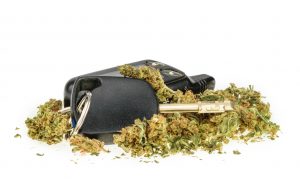 When a driver is prosecuted for operating a vehicle under the influence of drugs (called ‘OVI’ in Ohio), what evidence is sufficient to sustain a conviction? The prosecution must prove the defendant operated a vehicle under the influence of a drug of abuse. That requires the prosecution to prove the defendant was impaired while operating the vehicle, identify the specific drug which was ingested, and link the drug’s ingestion to the defendant’s impairment.
When a driver is prosecuted for operating a vehicle under the influence of drugs (called ‘OVI’ in Ohio), what evidence is sufficient to sustain a conviction? The prosecution must prove the defendant operated a vehicle under the influence of a drug of abuse. That requires the prosecution to prove the defendant was impaired while operating the vehicle, identify the specific drug which was ingested, and link the drug’s ingestion to the defendant’s impairment.
Articles Tagged with Drugged driving
Coming to Ohio: Oral Fluid Tests for DUI/OVI

According to a news report by NBC4 Columbus, the state of Ohio intends to use oral fluid testing to obtain evidence of drugged driving. In the video from NBC4, the Ohio Traffic Safety Council indicates there are increasing numbers of crashes caused by drug-impaired drivers. To combat this problem, the Traffic Safety Council recommends that law enforcement agencies implement oral fluid testing. This testing method has some advantages over currently used drug tests, but it also has drawbacks.
Does Ohio’s Drugged Driving ‘Per Se’ Law Unconstitutionally Punish Status?
 When a person uses marijuana, the high from the THC last for about two hours, but the THC metabolites are detectable in the person’s urine for up to five weeks. Suppose a person smokes marijuana and a week later is pulled over and investigated for DUI (called ‘OVI’ in Ohio). If that person submits a urine sample and the urine test shows a prohibited level of marijuana metabolite, that person will be prosecuted for OVI because it is ‘per se’ illegal to operate a vehicle with a prohibited concentration of marijuana metabolites, even if the person’s driving is not impaired. Challenges to this ‘per se’ OVI law have been unsuccessful in Ohio courts. A recent case from the Ohio Supreme Court suggests the Court may be inclined to evaluate the constitutionality of the OVI ‘per se’ law for drugs.
When a person uses marijuana, the high from the THC last for about two hours, but the THC metabolites are detectable in the person’s urine for up to five weeks. Suppose a person smokes marijuana and a week later is pulled over and investigated for DUI (called ‘OVI’ in Ohio). If that person submits a urine sample and the urine test shows a prohibited level of marijuana metabolite, that person will be prosecuted for OVI because it is ‘per se’ illegal to operate a vehicle with a prohibited concentration of marijuana metabolites, even if the person’s driving is not impaired. Challenges to this ‘per se’ OVI law have been unsuccessful in Ohio courts. A recent case from the Ohio Supreme Court suggests the Court may be inclined to evaluate the constitutionality of the OVI ‘per se’ law for drugs.
How Does Ohio OVI / DUI Law Address Medical Marijuana?
 We’ve used this space in the past to discuss how the nationwide trend in marijuana legalization has impacted the enforcement of DUI laws (called ‘OVI in Ohio’). After last week’s election, 37 states plus Washington D.C. have now legalized marijuana in some fashion. While recreational use of marijuana has been decriminalized (but not legalized) in Ohio, medical marijuana has been legal here since 2016. What does this mean for marijuana DUI charges? Could changes to Ohio’s OVI laws be on the horizon?
We’ve used this space in the past to discuss how the nationwide trend in marijuana legalization has impacted the enforcement of DUI laws (called ‘OVI in Ohio’). After last week’s election, 37 states plus Washington D.C. have now legalized marijuana in some fashion. While recreational use of marijuana has been decriminalized (but not legalized) in Ohio, medical marijuana has been legal here since 2016. What does this mean for marijuana DUI charges? Could changes to Ohio’s OVI laws be on the horizon?
Should Ohio Repeal The Marijuana DUI/OVI ‘Per Se’ Law?
 Most states now have some form of legalized marijuana. Thirty-four states (as well as D.C., Guam and Puerto Rico) have medical marijuana programs, and ten states permit recreational marijuana use. The states with recreational marijuana have questioned whether marijuana legalization results in more traffic accidents. According to a recent article in the USA Today, the answer seems to be ‘no’. Nevertheless, Ohio aggressively enforces a flawed marijuana DUI law (called ‘OVI’ in Ohio).
Most states now have some form of legalized marijuana. Thirty-four states (as well as D.C., Guam and Puerto Rico) have medical marijuana programs, and ten states permit recreational marijuana use. The states with recreational marijuana have questioned whether marijuana legalization results in more traffic accidents. According to a recent article in the USA Today, the answer seems to be ‘no’. Nevertheless, Ohio aggressively enforces a flawed marijuana DUI law (called ‘OVI’ in Ohio).
Prosecution Must Prove All Elements For Charges of DUI/OVI Drugs In Ohio
 There is a difference between what generally ‘makes sense’ and what is sufficient evidence in court. In a recent Ohio DUI/OVI case, the prosecution’s failure to prove all the elements of an offense resulted in one conviction being reversed and probably should have resulted in a second conviction being reversed as well. This case from an Ohio court of appeals also illustrates important lessons for litigating DUI/OVI cases involving drugs.
There is a difference between what generally ‘makes sense’ and what is sufficient evidence in court. In a recent Ohio DUI/OVI case, the prosecution’s failure to prove all the elements of an offense resulted in one conviction being reversed and probably should have resulted in a second conviction being reversed as well. This case from an Ohio court of appeals also illustrates important lessons for litigating DUI/OVI cases involving drugs.
Changing Marijuana Laws Affect DUI/OVI Charges
 As of January 1, 2020, 11 states and Washington D.C. have legalized recreational marijuana use. That number increases to 33 states when you include medical legalization. Several studies have been conducted to determine what effect this ever-growing legal access to marijuana has had on traffic and DUI/OVI statistics. While more data will be needed to ultimately determine the true effect of legalization, these studies indicate there has been an impact.
As of January 1, 2020, 11 states and Washington D.C. have legalized recreational marijuana use. That number increases to 33 states when you include medical legalization. Several studies have been conducted to determine what effect this ever-growing legal access to marijuana has had on traffic and DUI/OVI statistics. While more data will be needed to ultimately determine the true effect of legalization, these studies indicate there has been an impact.
Should Ohio Use Roadside Drug Test For Marijuana DUI / OVI?
 The ever-growing number of states which have legalized either medical marijuana or recreational marijuana has created a number of issues for law enforcement and the justice system. Chief among those issues is the challenge of enforcing laws against operating a vehicle under the influence of marijuana. In an effort to overcome this challenge, the Norwegian company Drauger developed the DrugTest 5000. This system uses a mouth swab, taken roadside, to help determine if a driver is under the influence of marijuana or other drugs. The DrugTest 5000 has been in use in Norway since 2015 and has seen growing use in the United States. This test, however, is probably not the solution for law enforcement’s problems.
The ever-growing number of states which have legalized either medical marijuana or recreational marijuana has created a number of issues for law enforcement and the justice system. Chief among those issues is the challenge of enforcing laws against operating a vehicle under the influence of marijuana. In an effort to overcome this challenge, the Norwegian company Drauger developed the DrugTest 5000. This system uses a mouth swab, taken roadside, to help determine if a driver is under the influence of marijuana or other drugs. The DrugTest 5000 has been in use in Norway since 2015 and has seen growing use in the United States. This test, however, is probably not the solution for law enforcement’s problems.
Tiger Woods DUI Arrest Spotlights Complicated Problem Of Drugged Driving

After Tiger Woods’ recent DUI arrest, he issued a statement in which he said, “I want the public to know alcohol was not involved. What happened was an unexpected reaction to prescribed medications.” Prescription medications, as well as non-prescribed drugs, account for an increasing number of DUI/OVI cases in Ohio and throughout the United States. Tiger’s situation very publicly spotlights the complicated problem of drugged driving.
Ohio Supreme Court Paves Prosecution’s Path For Drugged Driving Convictions
 Bad Facts Make Bad Law
Bad Facts Make Bad Law
If a police officer says a driver was under the influence of a drug, there is no need for testimony from an expert regarding whether the drug actually impairs driving. That is, essentially, the conclusion of the Ohio Supreme Court’s decision in State v. Richardson. There is a saying among lawyers: “bad facts make bad law”. The precedent created by this case may qualify as ‘bad law’, and the circumstances of the case definitely qualifiy as ‘bad facts’. Continue Reading
 Columbus OVI/DUI Attorney Blog
Columbus OVI/DUI Attorney Blog

